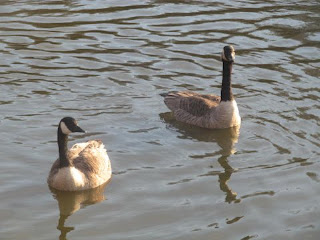Every season brings its own changes and challenges.
For young Canada geese (not quite a year old and still hanging with parents), the rude awakenings of spring are marked by banishment from the family when parents once again prepare for romance and nesting.
Hansel and Greta returned again to their nesting location at the Central Park Reservoir this past week. But they were not alone.
Their three goslings from last year were tagging along with them.
The long-mated pair had returned earlier in the beginning of March.
But a bitter cold turn in weather and a mid-March blizzard compelled the devoted couple to suddenly abandon plans and apparently scurry back to their kids from last year in order to guide the youngsters through the storm.
With the calendar moving on however, and weather finally starting to warm, the entire family returned to the Reservoir in recent days.
But Hansel was having no part of the three kids continuing to hang with him and his wife -- especially now. Though the youngsters attempted to maintain a respectable distance from their parents, Hansel wanted them gone. Entirely.
Time and again, Hansel loudly honked and charged after the yearlings, sometimes even nipping them hard on their tails.
The message was harsh and clear: "Your mother and I are to be left alone now! It's time for the three of you to move on. You are not babies anymore!"
Though it is initially hard for the yearlings to receive this "rejection" from their parents, eventually they get the message. It is all part of growing up and becoming adult. It is necessary part of nature and the life cycle -- though to the casual observer, it sometimes appears cruel and even a bit brutal.
I knew, when seeing this normal ritual play out again earlier in the week, that I would likely not see Hansel and Greta's youngsters again for at least the rest of the spring. Should the alpha pair of geese successfully hatch new goslings again, then there can be no family reunions until well into the summer when the new babies are grown and flying.
And, if it wasn't enough to watch the banishment of Hansel and Greta's youngsters earlier in the week, there was the additional sighting yesterday of the return of the other nesting pair of Reservoir geese, John and Mary. They too, had last year's (two) goslings tagging cautiously along with them.
But not for long.
In repeat of earlier scenes, it was clear that the yearlings had worn out their welcome. Only this time, both parents chased and honked at the now rejected offspring. Mary was every bit as fervent in setting down rules as her mate, John (unlike the more reserved Greta who usually lets her mate to the dirty work).
I have not seen the kids of Hansel and Greta since their unceremonious banishment earlier in the week and it's equally unlikely I will be seeing much of John and Mary's offspring anytime soon.
For now, all banished youngsters will seek out gaggles of other young and "unattached" geese with whom to spend the rest of spring and most of the summer as their parents now have other duties calling and need to be completely devoted and focused to those.
Then, when the seasons of romance and rearing of young are finally over, families will once again reunite in late August or September in order to prepare for fall migrations and winter.
For every time and season there is purpose and challenge.
And Canada geese understand these rules of nature all too well -- as do most wildlife.
Turn, turn, turn. -- PCA
*********





























